Apple's 2010 MacBook Air (11 & 13 inch) Thoroughly Reviewed
by Anand Lal Shimpi on October 26, 2010 10:08 PM EST- Posted in
- Mac
- Apple
- MacBook Air
- Laptops
The 11-inch as a Windows Notebook
As a follow-up to our Nvidia 320M/MacBook Pro 13 article last week, I’ve been running our Windows test suite on the MacBook Air 11”. I, like Anand, have the lowest end 11”er, with 2GB memory and the 64GB SSD. This makes installing Windows an interesting proposition since after the two OS installs, you’ve got right around 30GB of free disk space to work with. My suggestion - if you plan on installing Windows and dual booting often, save yourself the headache and get the 128GB model.
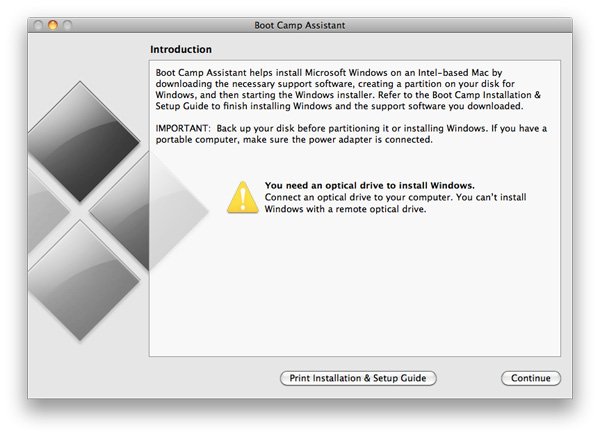
The other quirk with putting Windows on the Air is that it must be done with a USB optical drive - no hard drive/thumb drive installs. Interestingly, my external optical drive wasn’t recognized as a bootable drive, so I had to run out and grab an Apple SuperDrive. Apple says that you just need an external DVD drive, without specifying the MacBook Air SuperDrive, but your mileage may vary.
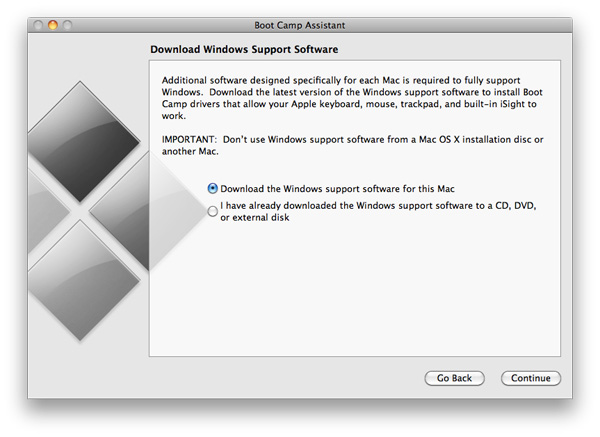
Boot Camp Drivers are now downloaded from Apple's servers prior to the Windows installation
With the Windows install out of the way, we were free to test the living daylights out of it, and that we most certainly did. The 11” Air has the same 1.4GHz Core 2 Duo SU9400 as the similarly thin Dell Adamo 13. Months after we move to Arrandale ULV, leave it to Apple to bring the good old CULV platform back to relevance. As expected, Cinebench and the x264 encoding test gave us results around the same level as the Adamo and the rest of the old CULV gang. Versus the 13” MacBook Pro, you’re looking at roughly a 40% decrease in the CPU compute-heavy benchmarks, roughly equivalent to the reduction in clock speed from the 2.4GHz Pro to the 1.4GHz Air. Arrandale ULV notebooks, such as the Alienware M11x and its Core i7-620UM, are another matter entirely, with the newer architecture posting numbers nearly doubling the Air’s Core 2 processor.
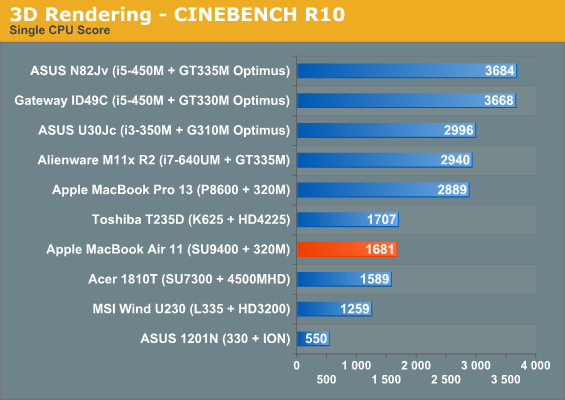
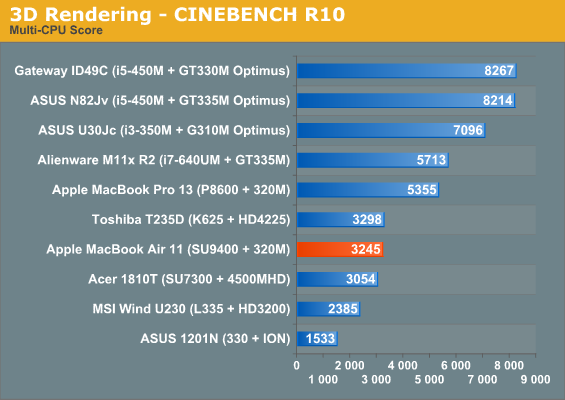
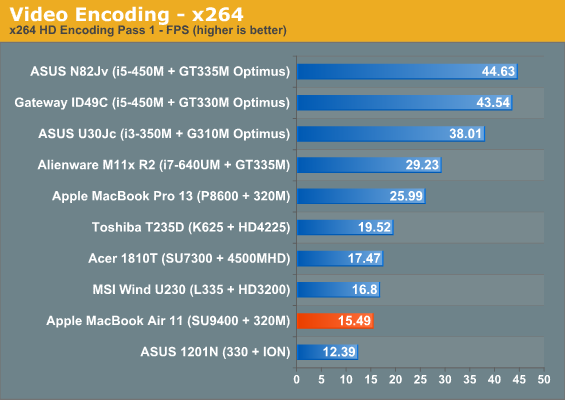

The gaming benchmarks get a bit more interesting. We’re looking at the same GT 216-derived GeForce 320M that was in the MacBook Pro 13, with the same 450MHz core and 950MHz shader clocks. Based on the performance we saw out of the Pro 13, we know that the Air, even in 11” form, can still hold its own in games.
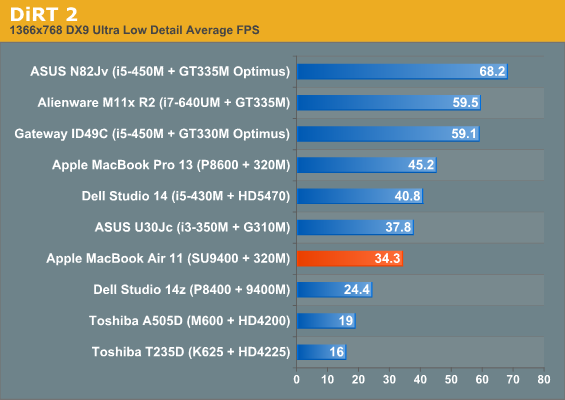
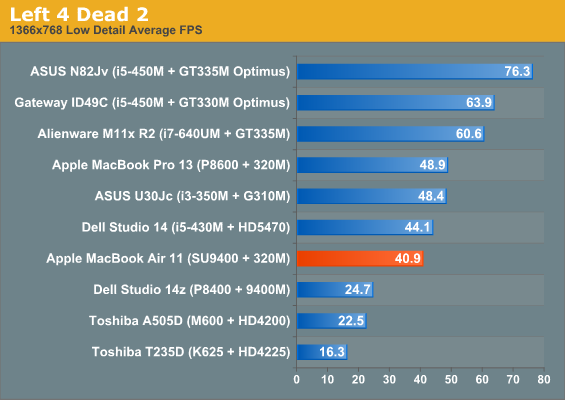
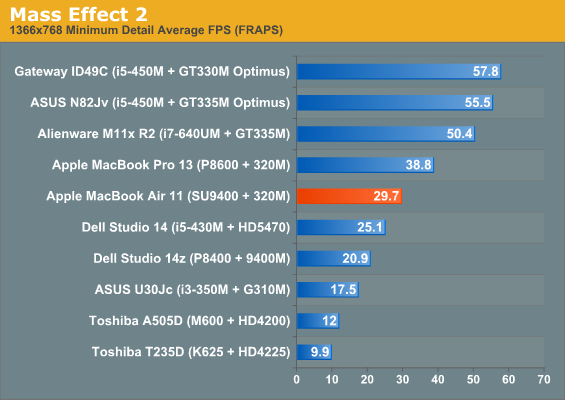
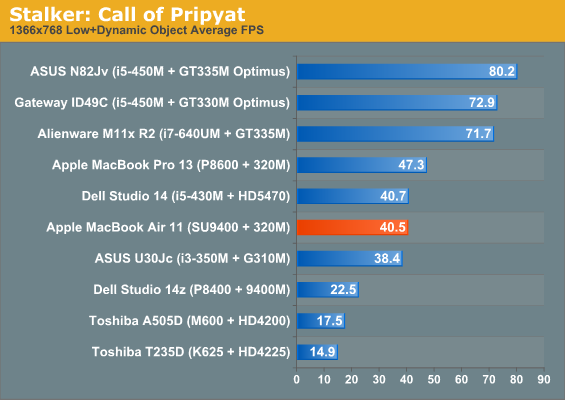
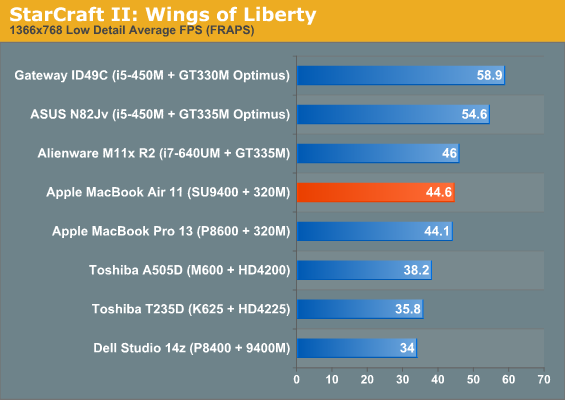
At low detail settings, the Air is pretty consistently 20% slower than the Pro 13, except in SC2, where they were roughly equal. Given that the GPU is identical and that both are using 256MB of the system’s DDR3 1066 memory, it is likely that the 1.4GHz Core 2 Duo is slow enough to put a bottleneck on gaming performance. It’s still a ways ahead of the ASUS Core i3/G 310M combo, and all of our games are playable at native resolution.
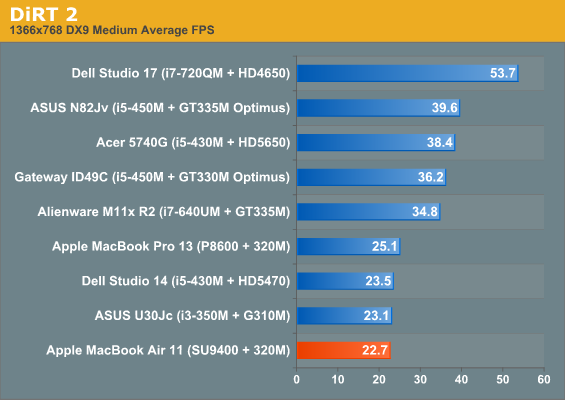
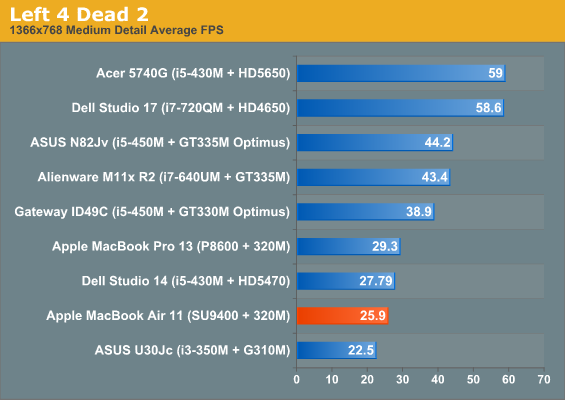
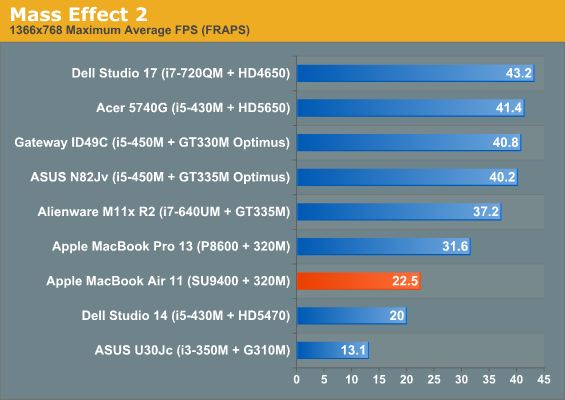
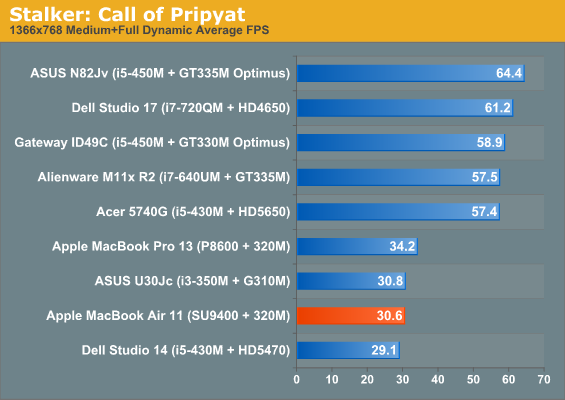
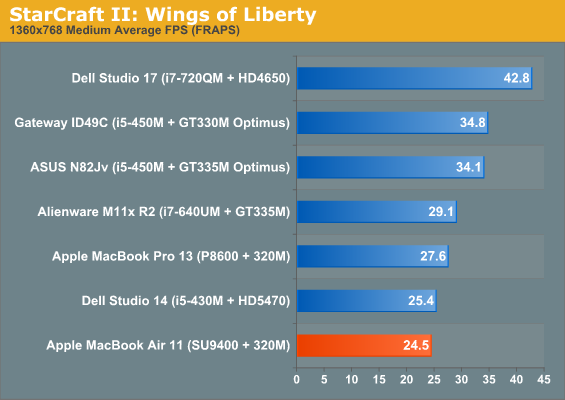
At medium settings though, the Air starts to fall off a bit. Where the MBP13 was borderline-playable, always between the 25-35 fps range, the Air is about 10% behind and makes it to the magical 30fps mark in STALKER, but nothing else. DiRT 2, Left 4Dead 2, Mass Effect 2, and StarCraft II all ended up between 22 and 26 fps, still faster than the G 310M, but not quite playable. Another interesting concern during gaming is heat. The Air isn’t the coolest notebook in the world, with idle temps hovering around 50C, but while running the gaming tests, I saw GPU temps rise up into the 70s. Nothing too alarming, but still pretty toasty and more than enough to get the fans spinning to the max.
But let’s put this all in perspective. This isn’t about just an 11.6” notebook that can game - the 11.6” M11x is the fastest gaming notebook under 5lbs, but even then it’s still a full two times heavier than the MB Air 11. The Air 11 shoehorns quite a bit of power into one of the smallest form factors on the market. Having a GT 216 core in an enclosure this small and being able to run these games at 40 fps at native resolution is definitely very impressive.










185 Comments
View All Comments
solgae1784 - Wednesday, October 27, 2010 - link
Retracting my last part of my comment.....Dell XPS 15" line does have a 1080p option.Accord99 - Thursday, October 28, 2010 - link
Lenovo offers a 1920x1080 option on the T510/W510, Dell also offers it on their Studio 15, Latitude E6510 and Precision M4500 models. Asus has a number of models like the N and G which have this option, as does Sony, including the expensive 13.3" Z.Penti - Thursday, October 28, 2010 - link
Business laptops like from HP, Dell, Toshiba, Lenovo, Sony and Fujitsu has high-res screens, 13.1" 1600x900 displays, 14" 1600x900 displays, 15" 1600x900 displays and 1920x1080, and so on. (With Dell think E5510 or E6510). Those start at ~999 dollar though. But everything isn't consumer shit.ssd_trimmer - Tuesday, October 26, 2010 - link
I understand that Mac OS X does not yet support TRIM, but does the underlying SSD support it? I hope to run Fedora on a Macbook Air 13.MacTheSpoon - Tuesday, October 26, 2010 - link
As a writer, I paid a premium for my Vaio X so I could have a very light machine with all-day battery life and a bright, matte screen to use outside on sunny days. The tradeoffs have been a cramped keyboard (especially annoying for its horribly small "shift" key); a puny track pad (without two-finger scrolling, which I really miss); and a sluggish processor.I had some hope that the 11" MBA might be a viable alternative, but its lack of a matte screen, its low battery life (compared to a good netbook and certainly compared to my 12+ hour Vaio X), and even its surprisingly high weight for its battery life are keeping me from switching over, even taking into account its fantastic keyboard/track pad that I am drooling over with envy.
Furthermore, thought it's more an observation than a major purchasing reason for me, comparing the two premium netbooks I have to give the edge to the Vaio X in terms of razzle dazzle factor, too, which is sad. I really thought Apple could one-up Sony in this respect. I'm not talking visual design as much as overall "cool" factor. How cool is it that I can swap out my extended battery and have a laptop that weighs as much as an iPad but plays Flash and lets me run desktop class programs? And even its ridiculously large maximum screen angle thrills me after years of suffering from my 15" 2007 MBP; I can open up the Vaio X screen so wide that it's practically flat. It's so comfortable to sit in bed and type with it propped against my knees and its screen wide open.
Anyway, I sure would have liked the 11" MBA to equal the Sony in its battery life and weight, and to throw in a matte screen for good measure, because I knew Apple would get the keyboard and track pad right--which they did. A similarly large screen opening angle would have been great, too. Then I would have switched very, very happily. As it is, I just can't justify it. I can't give up this battery life and outdoor suitability, even if typing is somewhat irritating.
solipsism - Tuesday, October 26, 2010 - link
The Vaio X runs an Atom CPU with an Intel GM500 IGP. When running the same Light Browsing test as Anand how much time can you actually get from your Vaio X? It’s really a $1300 netbook. It’s a great machine except for CPU/GPU/RAM, but you pay a lot for it. As for weight, it’s the same weight for the Vaio X once you pay extra for the 12 hours battery (that I hear gets you about 8-9 from Light Browsing).I disagree with calling any small ultra-portable a netbook based on the display size. These came about because of the cheap, low-power and slow Atom CPUs, and built up from that was the rest of the cheap HW, with a small display and cramped keyboard. The 11” MBA is not any of those things. That CPU alone cost more than most netbooks.
Wilcomhs - Tuesday, October 26, 2010 - link
Can we have some numbers for battery life under Win 7 please? 5 hours sounds acceptable but knowing the battery life hit going from OSX to Windows would help with making a decision here.CharonPDX - Wednesday, October 27, 2010 - link
Find me one other Core 2 Duo SU9400 equipped notebook that weighs under three pounds for anywhere near this price.Find me one other Core 2 Duo SU9400 equipped notebook with anything other than Intel graphics that weighs under three pounds - for ANY price.
The 11" MacBook Air is not a netbook. Repeat that again. The 11" MacBook Air is NOT A NETBOOK. It competes in the "ultra thin/light performance notebook" segment, and it dominates it. It is lighter than almost every other notebook in its class, has the best graphics in its class, hands down (I have found a few four-pound models that have a GeForce 105M,) and it costs significantly less than anything else in its class.
The 13" model has a *LOT* more competition, because at 13", you can actually get moderate graphics and/or a decent price. But in the 11" space, the Air is all by itself.
khimera2000 - Wednesday, October 27, 2010 - link
its a netbook becaus other then web, writing, and instant messaging theres not much more you can do with it. not to mention it impimants its HDD in a similar maner as netbooks, and has no optical drive just like net books, has a weaker video card just like a netbook... this thing is a netbook, becaus theres nothing much else it can do. it fills the lower performance segmant of the notebook market, and its ultra portable which was what the netbook did.Demoure - Wednesday, October 27, 2010 - link
However, optical drives are not as important as they used to be, the video card is more powerful than that of many large notebooks sporting intel graphics, many netbooks use real hard drives, and a laptop of this power can do more than just web, writing, and messaging. It will manage to play movies, to photo editing, and low end gaming just fine, and I can't think of anything else you would want to do with a mobile device?